Chapter 7 – A Window into the Indigenous Science of Some Indigenous Peoples of Northwestern North America
Gloria Snively and John Corsiglia
The Indigenous peoples who live in Northwestern North America, specifically those who live in present day British Columbia and in southwest Alaska and Yukon Territory adjacent to British Columbia, eastward to the Rocky Mountains and southward to the Columbia River, inhabit a region with a remarkable wealth of natural resources. The northwest coast is home for a variety of land and sea mammals as well as an abundance of edible intertidal invertebrates (clams, mussels, crabs, shrimp, snails, chitons, sea cucumbers, and sea urchins) and seaweeds. Great flocks of waterfowl and teeming hordes of fish migrate from the ocean up rivers and streams to interior lakes. Deer, elk, moose, caribou, mountain goat, black bears, grizzly bears, as well as numerous smaller mammals found shelter and abundant food among the mountains or in coastal and interior forests. However, these riches of nature are not always abundant year-round or entirely free for the taking. Some of them, on the contrary, are exceptionally difficult to access or capture.
It was Indigenous Science and technology, plus the knowledge of its application, that provided the vital means for ensuring a reliable food supply year round, as well as a sustainable range of resources in the area. These techniques and wisdom practices did not suddenly spring into being. They developed slowly and painstakingly as more effective variations were invented or introduced and applied to achieve more effective results. In every community, extending back thousands of years, there have been men and women who were experts in their knowledge of plants, animals, and the environment. The final result produced some of the most elaborate and productive fishing, hunting, agricultural—and on the coast aquaculture societies that knew how to live well, and who knew how to selectively harvest, thus sustaining the resources they used for their own purposes and for future generations.
Many different peoples developed immense knowledge systems, created rich and rewarding cultures filled with strong family and community bonds, artistic expression, ritual and ceremony, and enduring relationships with other species—the plants and animals of their home territory.
One of the roles of Elders and knowledge holders is to find ways of passing on what they learned in their own lifetimes to the next generation so that its members would be able to benefit materially and culturally from this knowledge and wisdom. We must infer that this cycle of learning, observing, predicting, using, inventing, adapting, experimenting and sharing ecological wisdom, technological breakthroughs and cultural knowledge has been occurring in Northwestern North America since time immemorial—since before recorded history (Turner, 2014a, 2014b).
In the school system, however, examples of Indigenous innovations in science textbooks have been largely limited to Indigenous technologies such as fish traps and other fishing technology, carving totem poles and dugout canoes, and weaving cedar bark baskets. In this chapter, we bring to the attention of educators the science knowledge and processes underlying such innovations. In addition, we provide a broader range of traditional wisdom practices and Indigenous Science innovations that can be included in school curricula. It is our hope that teachers, parents, and readers will strive for effective ways to inform and inspire all our children.
Working with Trees and Plants
As a result of working with versatile cedars and other kinds of trees for thousands of years, generations of Aboriginal woodworkers perfected various technologies for felling and transporting trees, splitting and cutting planks, joining pieces of wood together, steaming and bending wood, weaving fibres, sanding and finishing products, patching and repairing products, as well as carving and painting products.
Western red cedar was vital to the life of BC Indigenous peoples. Red cedar grows tall and straight, with straight grain, both strong and flexible, bending under the weight of snow. The inner bark also has strength of flexibility, and in soils without large rocks, the roots run straight and even. But it is the lightweight reddish brown wood that runs straight without knots that gives the cedar its distinction.
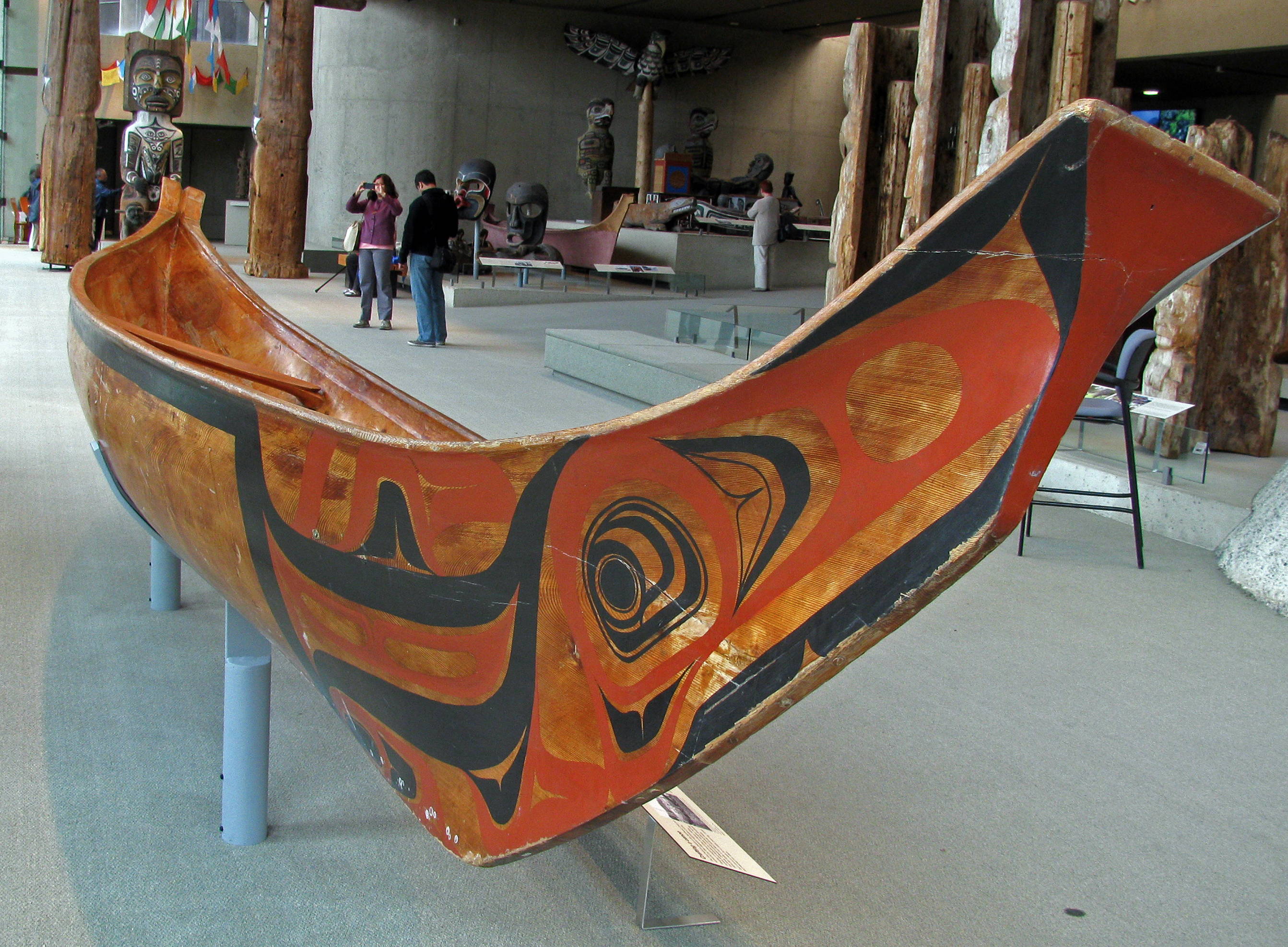
Made of a single western red cedar log, the dugout canoe of the Northwest Coast was central to the way of life of these ocean-going peoples. “Nowhere else in the world was a dugout developed to such a degree of sophistication; no other people had a dugout that could match the speed, capacity and seaworthiness—or the elegant grace—of the sleek canoes of the Northwest Coast Indian” (Stewart, 1984, p. 48). The earliest European explorers to visit the coast, who knew good boats, marveled that “the construction was so perfect, that not even an expert could detect the least flaw or imperfection” (Rev. Charles Moser, as cited in Stewart , 1977, p. 48). Significantly, the hull designs of big ocean-going Haida dugout canoes were later used for the fastest sailing clipper ships that raced between North America and Europe.
At Fort Langley, many newcomer Europeans were in awe of the quality of canoes that plied the waterways of coast and river. Without the canoes as a means of travel, hunting and transport, few villages could have prospered. Canoes were variously designed for different purposes and environments: large dugout canoes to withstand heavy waves and ocean storms in transport of people and goods (Figure 7.1); long sturdy dugout canoes for whaling (Figure 7.2); slender, simply built canoes for going upriver to hunt, set fishing nets and trade; and, long wide canoes for transporting goods long distances (Figure 7.3).
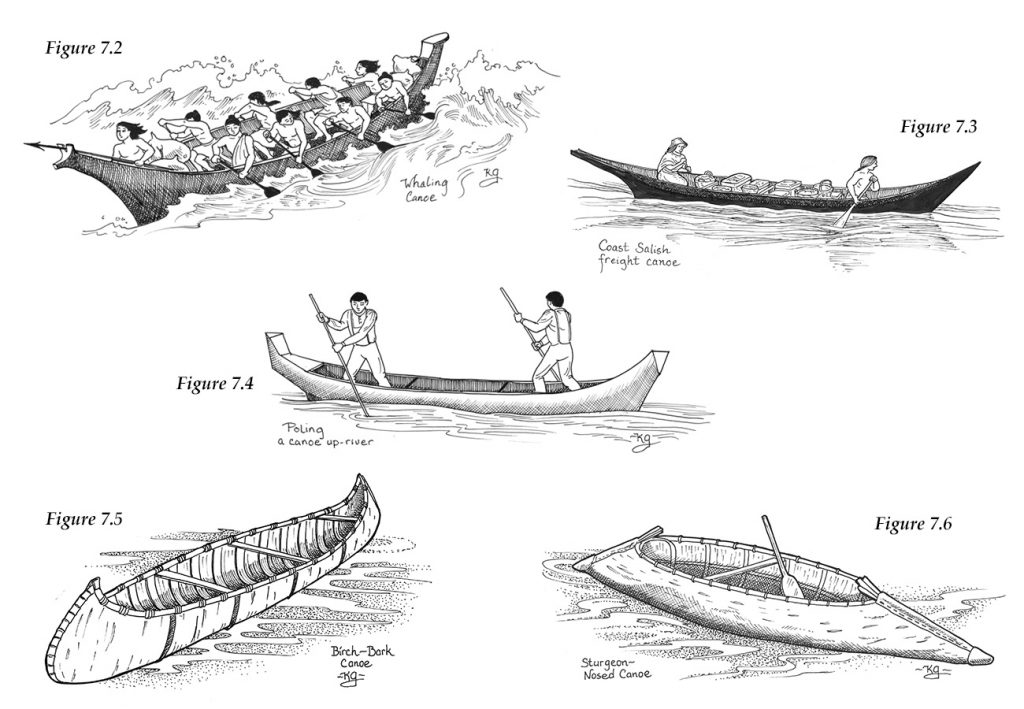
Figure 7.3 ▲ Coast Salish canoe for general travel and transport of goods. Illustration by Karen Gillmore.
Figure 7.4 ▲ River canoes enabled trade between the interior and the coast well into the 20th century. Illustration by Karen Gillmore
Figure 7.5 ▲ Birch bark canoe. Illustration by Karen Gillmore.
Figure 7.6 ▲ Sturgeon-nosed canoe. Illustration by Karen Gillmore.
The Makah of the Olympic Peninsula, Washington and the Nuu-chah-nulth of southern Vancouver Island hunted whales and other mammals. Their canoes were virtually identical. The Nuu-chah-nulth canoe was extremely seaworthy. Their flatter bottom allowed for easy beaching and loading, and their flared width gave them exceptional stability as they pitched in ocean swells. Floats of sealskin, blown up like huge balloons, attached to the harpoon line slowed the whale and kept the dead whale from sinking. The Nuu-chah-nulth war canoe (not illustrated), with its flat bottom, “could plane at high speed” (skim along the top of the water) (Ahousaht Chief Edwin Frank Sr. to John Corsiglia, personal communication, 1998).
The rivers of central BC are shallow, but swift, and their navigation required considerable skill. Canoes of somewhat varying shapes played a key part in transporting goods throughout the interior and enabling trade between the interior and the coast. The crew used paddles and long poles to guide the canoes away from violent eddies and in the right direction downstream, and to push or pull canoes upstream (Figure 7.4). The peoples of the eastern BC interior harvested white birch bark to build birch bark canoes for travelling rivers and lakes (Figure 7.5). Cottonwood has some of the same characteristics as red cedar and was used to make dugout canoes in the interior. Small amaal (cottonwood) canoes were left at crossing points along portage trails for travellers crossing in either direction (Nisga’a Bert McKay to John Corsiglia, personal communication, 1979).
Ingeniously, the people of the Kootenay interior (the Ktunaxa Nation) made the sturgeon-nosed canoe that they adapted to a wetland environment. The flat bottom and pointed nose allowed the canoe to easily go through the reeds and high grass of marshlands enabling the people to gather food (Figure 7.6).
One of the greatest achievements of early Northwest Coast peoples was the building of large houses using massive cedar beams. A visit to such a house staggered the imagination of Capt. John Meares, who sailed the coast in 1788, and his journey entry well expressed his sense of awe:
The trees that supported the roof were of a size which would render the mast of a first-rate man of war diminutive, on a comparison with them; indeed our curiosity as well as our astonishment was on its utmost stretch, when we considered the strength that must be necessary to raise these enormous beams to their present elevation; and how such strength could be found by a people wholly unacquainted with mechanical powers (Stewart, 1984, p. 61).
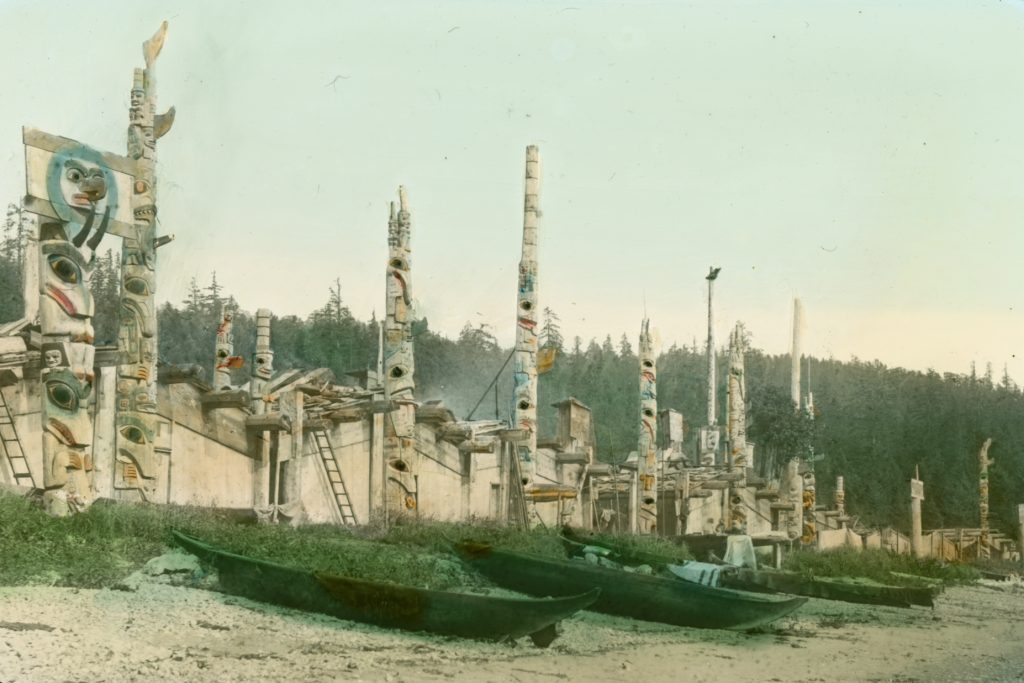
All along the Pacific Northwest Coast, marine-oriented people faced the water. Generally built close to one another, the houses hugged the water’s edge wherever there was a beach, fresh water and a means to make a living. Some of the best examples of early large cedar houses were photographed at Skidegate, Haida Guaii by George M. Dawson during his travels in the early 1900’s (Figure 7.7). One of the best examples of the framework of a large house with fluted beams is in the Kwakiutl village of Mamalilikulla on Village Island near Yalis (Figure 7.8 and Figure 7.9).
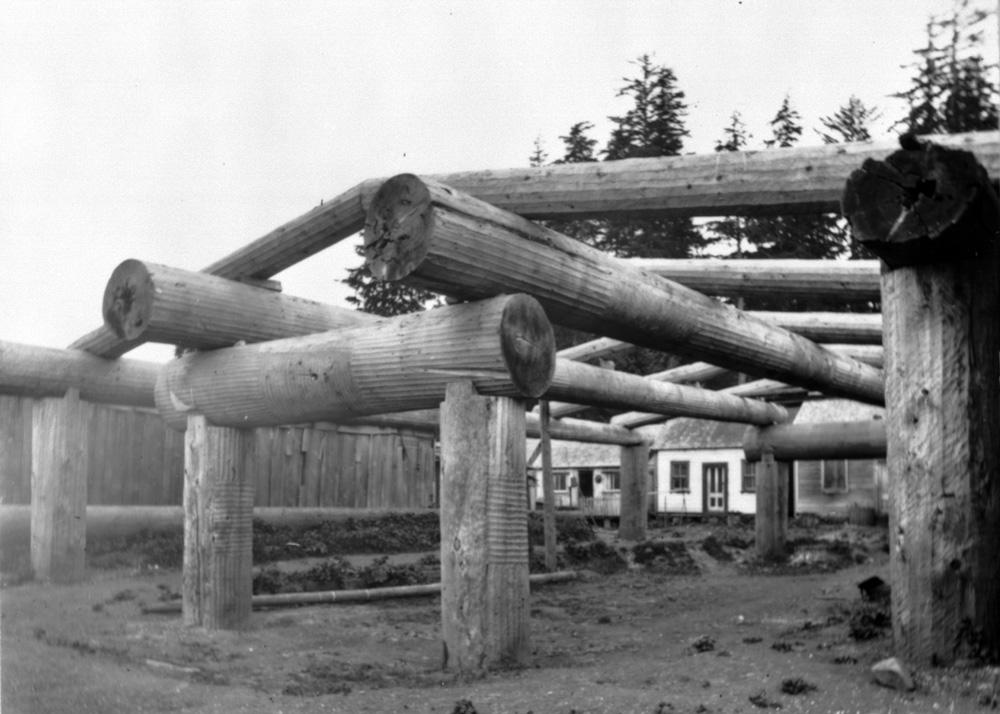
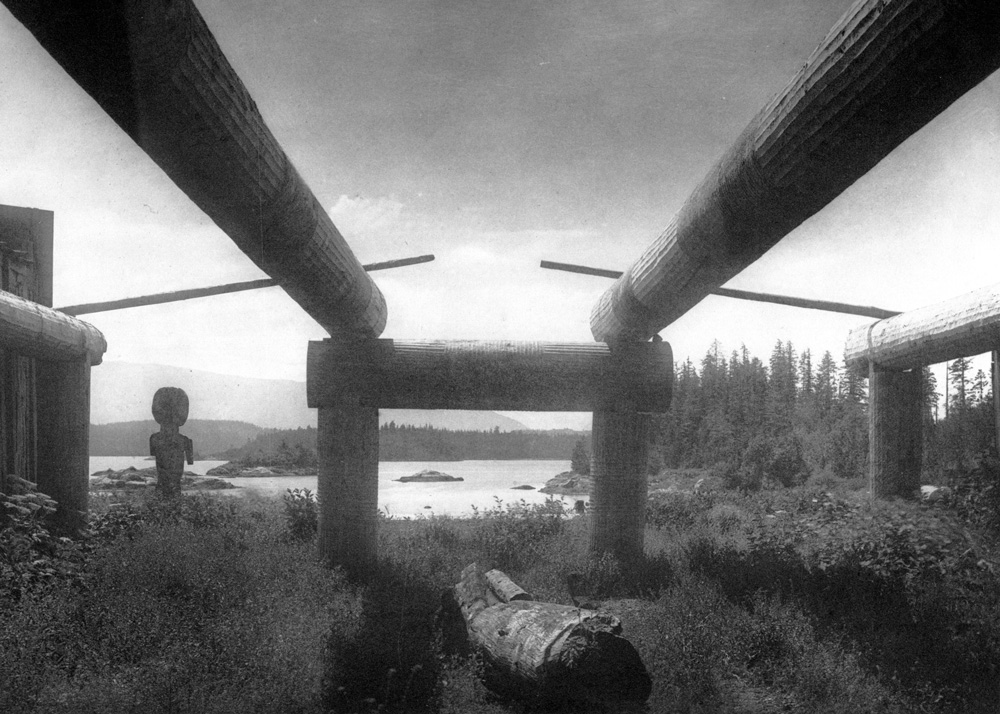
These early explorers did not know that for centuries, Indigenous woodworkers and house builders had mastered post and beam construction, as well as the technology for raising massive cedar beams some 20 or 30 metres long, weighing more than ten tons, that could span open plan buildings and support roofs that could hold many tons of snow. One method was by moving the beam along an angled skid using levers, fulcrum, ropes and manpower (Figure 7.10).
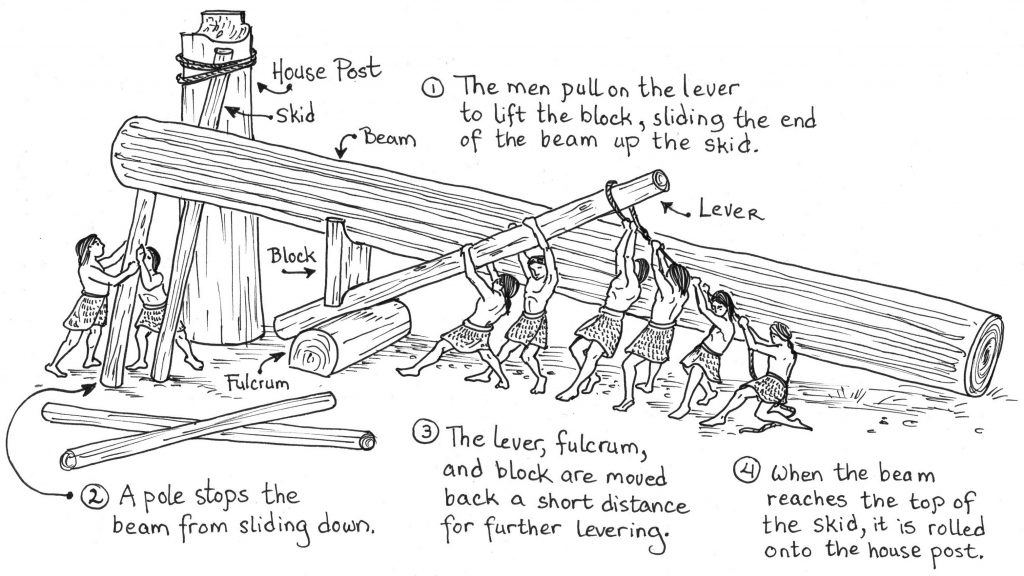
Harold Wright (Nisga’a Elder) told the author (personal communication, 1977) that the method used to raise a massive house’s beams was to build a structural crib—in a fashion similar to the way squared timbers are stacked in alternating pairs to level campers, trailers, and move houses today. A crib of short squared timbers was stacked under a beam’s balance point and then a sure-footed man walked to one end of the beam to raise the other end. As the balanced beam was rockered by the weight of a man moving end to end, blocks of varying thickness added to the square crib increased its height and thereby raised the beam incrementally. The process would be repeated with the beam raising a small vertical distance each time as they “teeter tottered” back and forth and new support planks were added. The beam’s flat bottom contributed to stability. The energy supplied by one man moving back and forth was sufficient to jack up the beam (Figure 7.11).
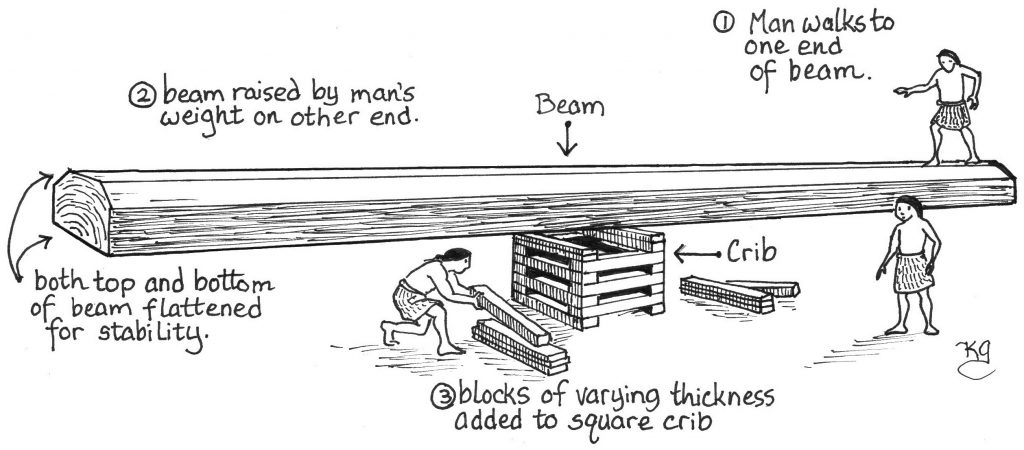
Similarly, the raising of a totem pole can require a hundred or more men and the precise knowledge and skills required to build a strong scaffold and support crossbar, and by resting the pole on a crutch between stages of raising. In most communities, the pole is still raised in the traditional manner, followed by a great potlatch (feast) and speeches. Rattles were fashioned from a wide assortment of materials to accompany such occasions: pectin shells, puffin beaks, deer hooves, mountain goat hooves, bear claws, hollowed wood and pebbles. A variety of single-note whistles and some with two and three notes were used to create the sounds of supernatural and spirit creatures. Food played a major part in any important occasion. Enormous feast dishes, each carved from a large block of wood, and cedar baskets of various sizes and types held great quantities of prepared food for huge numbers of guests (Stewart, 1984).
While harvesting cedar and building large structures was almost the exclusive work of men, women worked almost exclusively with the inner bark and roots to weave a wide assortment of products, but it was only during the spring and summer months when the sap was running that pulling off the bark was possible. The women would look for a tall straight tree with few or no branches on one side. Stripping the bark from only one side allowed the tree to live, thus ensuring a sustainable harvest in the area (Figure 7.12). As with all natural resources, the people expressed gratitude. To show respect was to ensure a good supply in future years. After selecting a tree, the women would address the spirit of the tree in a prayer of respect, thanking it for being a good provider and asking it for some of its dress (bark) explaining why they needed it (Stewart, 1984).
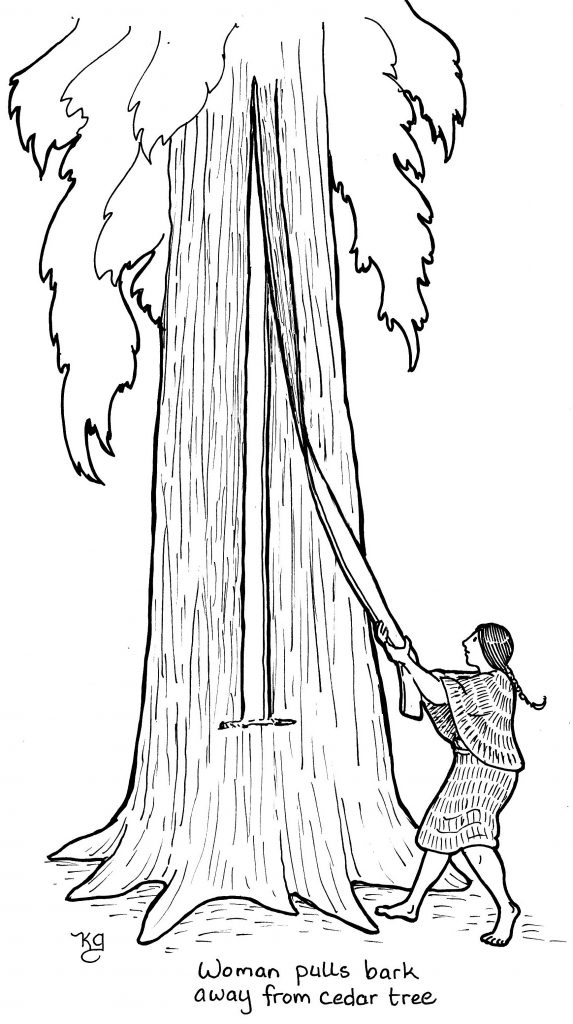
From the cedar bark and roots, women made baskets, bags, floor mats, clothing, hats, canoe bailers, baby cradles, cooking and serving utensils, berry-picking baskets, snowshoes, and ropes (Figures 7.13, 7.14, and 7.16). For peoples who lived in the rain coast environment, where heavy rain and cold weather were frequent, clothing made from shredded cedar bark oiled with oolichan grease gave protection from wind, rain and cold. The bark’s multiple layers of fibre provided good insulation. They used finely shredded inner bark to make tinder, brooms, paintbrushes, string, fishing lines, napkins, baby diapers, and bandaging (Stewart, 1984; Turner, 1998).
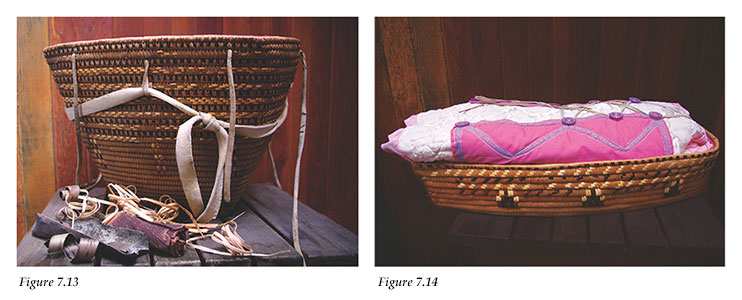
Figure 7.14 ▲ Baby cradle. New born babies sleep in these cradles for the first 2–3 months, they are laced in at night, and in the day time when people are working they can be nearby, the cradle can be propped up in a standing position when the baby is awake and people are working nearby. This cradle was made in 1975, by Adelina Williams of Mount Currie for her granddaughter G’emayts’a7 Megan Williams who owns the basket today. Photo by Alicia Corsiglia.

Figure 7.16 ▲ Lil’wat snowshoes for a child by Alec Peters. Photo by Simon Bedford (1970). Reprinted with permission.
Different cultural groups gathered available materials to make baskets and other products at different times of the year depending on the location: the bark and roots of red cedar, as well as white birch bark, spruce roots, reed canary grass, cattail, bull kelp, slough sedge and stinging nettle (Figure 7.15). Both coastal and interior peoples with highly developed understanding of plant materials made many types of baskets for many purposes—from small waterproof drinking cups to large storage baskets. Baskets were important for harvesting as they could be light and strong, shaped for convenient carrying of different foods and materials. Baskets were often decorated with designs and colours produced by developing dyes made from various plants. Cedar bark baskets tended to have less decoration than those made of other materials, with plaid or geometric designs made by overlaying bark strands dyed black or red. For black, dried year old cedar bark was buried in black swampy mud, leaving it for only a few days, otherwise the roots would rot. When the mud was washed off, the bark was stained a permanent black. The Bitter Cherry bark can be dyed black by burying it in iron-rich mud for several months. Today the dying process can be sped up by adding a few tin cans and rusty nails (Stewart, 1984; Turner, 1998). A beautiful red colour is obtained by simply using the natural Bitter Cherry bark.
Over the millennia, the Aboriginal peoples of BC became highly skilled in the arts of working with plant materials. The coiled split-cedar-root baskets with their intricate designs of both coastal and interior peoples are world famous. Beautiful coiled cedar-bark baskets and other products continue to be made by the Lil’wat people of Mount Currie.
Tanning Hides
Ingeniously, Indigenous peoples around the world used brain tanning, an ecologically sound form of aldehyde tanning, to soften and preserve hides. North American Indigenous peoples boiled the brains of bears, deer, moose, caribou, or buffalo to make a broth for tanning hides. Acidic chemicals in the broth soften the hides and alters the nature of the protein fibres in such a way that they resist decay. Hides (usually deer) continue to be tanned to make long-lasting and washable jackets, dresses, and moccasins, only today, the broth is often made by boiling egg yolks. Moose hide is used in making snowshoes. In fact, snowshoes, sleds, and toboggans are Indigenous technologies, as well as parkas and leather mittens.
Medicinal Uses of Plants
There are numerous documented medicinal uses of plants by the Indigenous peoples of BC. For example: tea made from yarrow leaves was used for colds; devil’s club for diabetes, arthritis and stomach problems; and ocean spray fruits for diarrhea, to name only a few (Turner & Peacock, 2005). Significantly, Western scientists have acknowledged numerous Indigenous remedies for specific ailments: using seawrack (a common seaweed) on burns and broadleaved plantain on insect bites (Nancy Turner, personal communication, March 2013). The bark of the Pacific Yew was used by the Indigenous peoples of Canada and the United States for treating many ailments, including some forms of cancer. It was not until the 1960’s that the anti-cancer agent Taxol O® was isolated by scientists and used in the treatment of cancer (Turner & Hebda, 1990).
Controlled Burning
Indigenous people of Canada (and throughout the Americas) developed highly articulated and effective approaches to grassland management. Most Indigenous people understood plant succession and many employed fire to encourage the growth of valuable plants, foster optimum habitat conditions, and control insect pests and disease (Turner, 1991; Turner & Peacock, 2005; Turner, 2014a, 2014b). In British Columbia, controlled burning was practiced on southern Vancouver Island to optimize the production of edible blue camas, which grows best in an open Garry oak meadow habitat (Figures 7.17, 7.18). The burning released nutrients into the soil and discouraged less useful plants that compete for sun and moisture, maintaining mosaics of grasslands rich in camas, deer forage, wild strawberries, blackcap and trailing blackberries; diversifying habitat and increasing options for food and other resources. When controlled understory burning was practiced, the carbohydrate-rich bulbs grew to the size of small table potatoes. Newcomer Europeans who misunderstood the practice and had very different land use agendas outlawed the Indigenous landscape burning practice. A century later camas bulbs, where they are found, are often significantly reduced in size and they are no longer widely gathered. Thus, according to Turner (1991), “the concept of genetic and ecotypic variability was obviously recognized by Indigenous peoples and was a factor in food gathering” (p. 18).
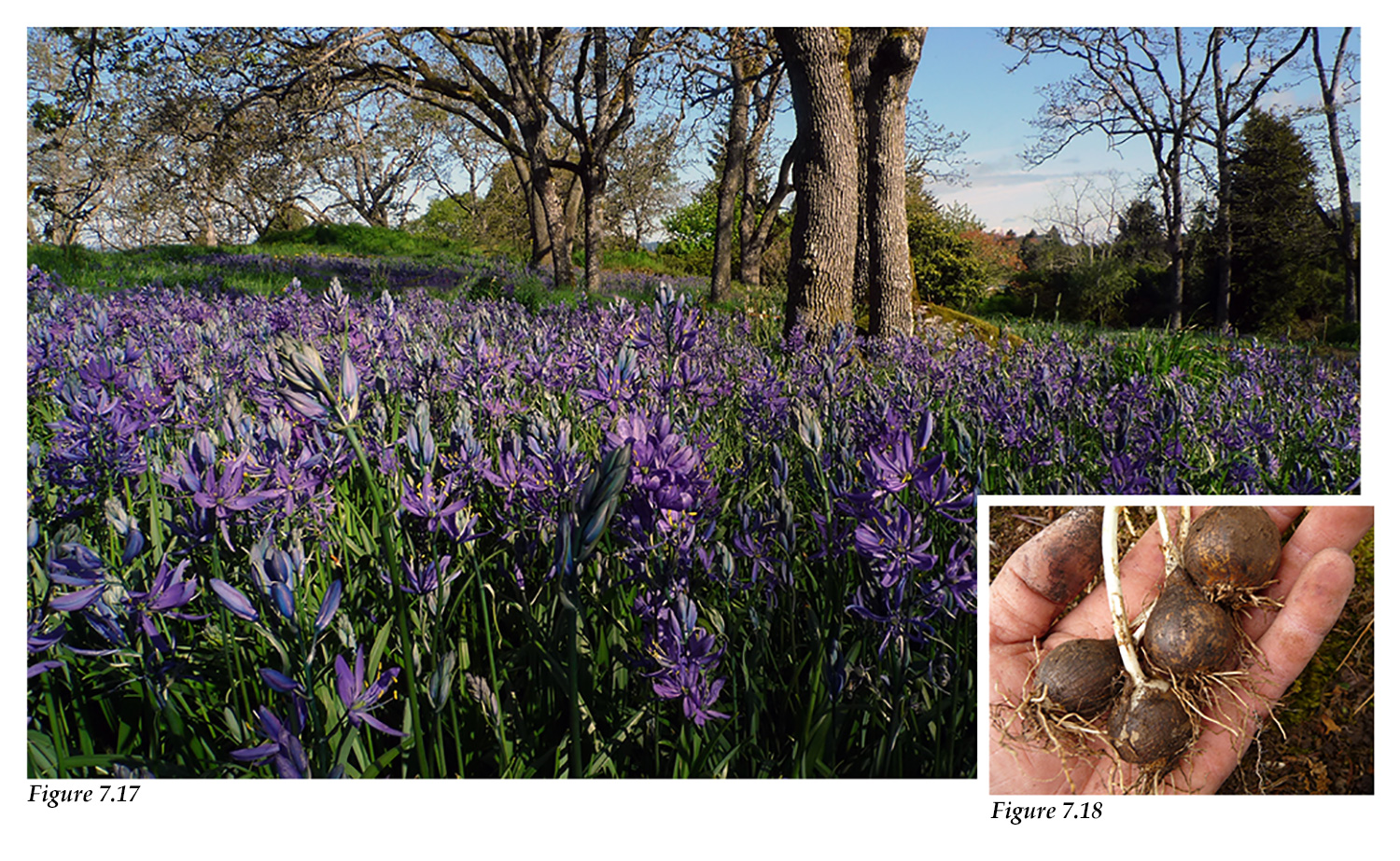
Figure 7.18 ▲ Blue Camas roots and bulbs. Photo by Abe Lloyd (2013). Reprinted with permission.
Productivity of a wide range of berries was increased by burning grasslands and hillsides, the pruning of berry bushes, selective harvesting, and the cultivation and transplanting of roots from one location to another. By researching the nature of people-plant interaction on the northwest coast, Turner and Peacock (2005) conclude that the Indigenous peoples were “active managers who promoted and valued plant resources and thus have much more in common with farmers than previously supposed” (p. 148).
Ancient Clam Gardens
Although never lost to Indigenous knowledge keepers, clam gardens have only recently been discovered by non-Indigenous northwest coast scholars (Figures 7.19, 7.20). Coastal habitat surveys of the BC coastline, and specifically of the Broughton Archipelago, reveal hundreds of stonewall features in the lower intertidal area that cannot be explained as fish traps. Through collaboration with Kwakwaka‘wakw Elders, Clan Chief Kwaxistalla (Adam Dick) and Mayanilth (Daisy Sewid-Smith), researchers have concluded that pre-contact Northwest Coast Indigenous peoples cultivated large quantities of preferred butter clams and cockles in walled sea gardens that may be unique in the world. The structures were created when:
Indigenous people, seeking to maximize clam production for an expanding population, rolled boulders to the extreme edge of a butter-clam bearing location to create a ridge parallel to the shore. Doing this extended the depth of beach out from the shore, and by integrating a series of small beds, it sometimes greatly lengthened the width of the butter-clam-bearing substrate. (Williams, 2006, p. 10)
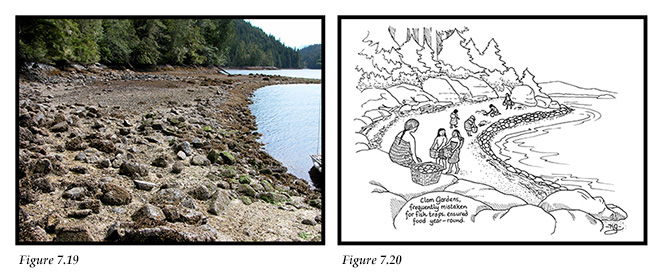
Figure 7.20 ▲ Clam gardens belong to individual families. Clams were roasted in their shells at the edge of fires, steamed in bentwood boxes, or braided into chains, smoked, and stored. Illustration by Karen Gillmore.
After building the walls, sediment, mud, and nutrients carried in by high tides would accumulate to create the ideal habitat for clam gardens. Families managed the intertidal plots and passed them down through generations. The tidal farmers would use digging sticks to turn over chunks of seafloor and aerate the sand (Figures 7.21, 7.22, 7.23). They selectively harvested the mature clams and left the smaller ones.

Figure 7.22 ▲ Cooking butter clams in a cedar bentwood box in Deep Harbour. The water boils when hot rocks are dropped into the box. Box made by Kwaxsistalla. Photo by Kim Recalma-Clutesi (2011). Reprinted with permission.
Figure 7.23 ▲ Clan Chief Kwaxsistella (Adam Dick) digging clams with the kil’luckw (yew wood digging stick) that he made, Deep Harbour, North Coast. Photo by Kim Recalma-Clutesi (2011). Reprinted with permission.
Over 2,000 culturally modified clam gardens have been identified in almost every river estuary and delta from northern California to Juneau, Alaska. Carbon dating suggests clam terraces to be up to 3,000 years old. The number of gardens, their long usage, and the labour involved in rock wall construction indicate that individual and clustered clam gardens were one of the foundation blocks of Indigenous economy for specific coastal people. Evidence of Indigenous knowledge and usage led astonished researchers to the conclusion that “Indigenous systems of sustainable clam production on the BC coast preceded modern shellfish mariculture installations by perhaps thousands of years” (Williams, 2006, p. 12; Caldwell et al., 2012).
Traditional Fishing Methods
Aboriginal peoples of BC devised a great many different styles of fishhooks, lures, traps, spears, harpoons and nets for capturing different species of fish in different environmental conditions. Contemporary photos and Elder accounts show that there are still Indigenous peoples who catch and preserve fish by methods little changed in hundreds—probably thousands of years. While the traditions still serve the people, the major changes are the materials used—a nylon net replaces one of nettle fibre, iron replaces bone for fishhooks, and Styrofoam floats replace inflated seal bladders.
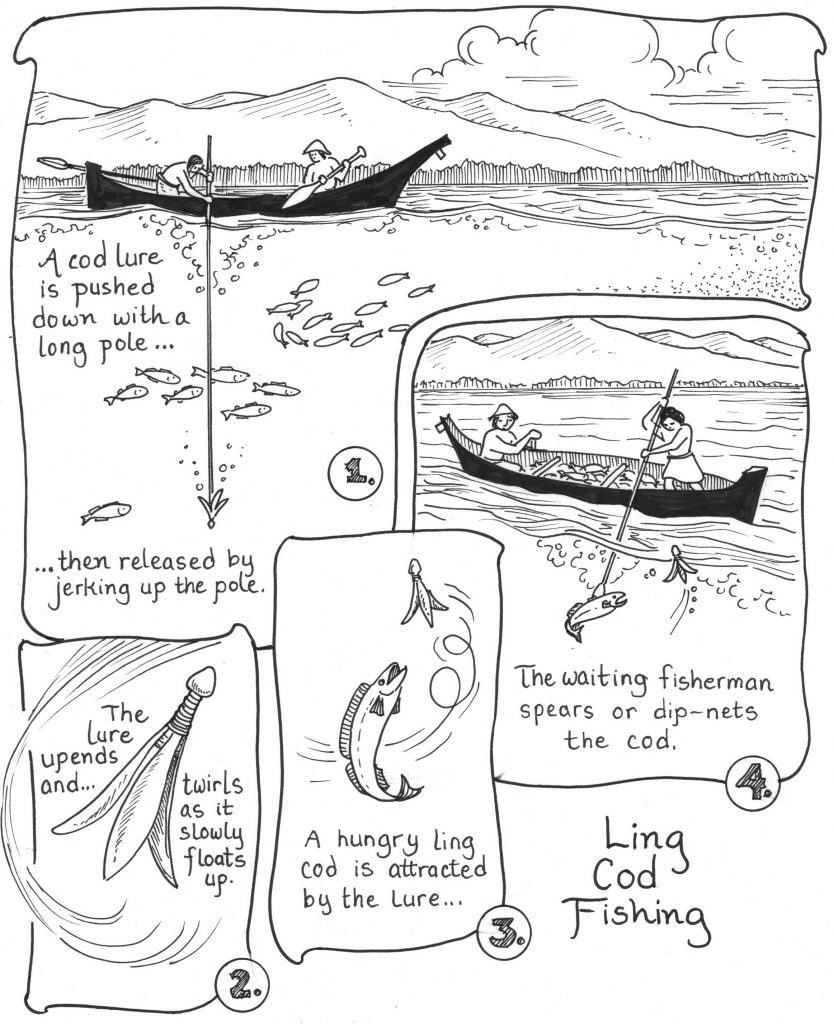
The traditional Indigenous peoples of the coast used lures in ways that reflected close observation and intimate knowledge of marine life. A sliver of willow—a white wood—carved in the shape of a fish gave a realistic imitation of a swimming fish as it was towed through the water. A piece of abalone glittering in the sunlight caught the attention of the fish.
Perhaps the most cleverly devised lures were those specifically designed to attract bottom fish such as cod and halibut (Figure 7.24). Pushed down into deep water on a long pole, it was designed to rise slowly and enticingly to the surface, where the fish that followed it up, with predictable curiosity, met the fisherman waiting with a spear or dip net in his hand” (Stewart, p. 56). The Nisga’a carved their cod lures from wa’umps (devil’s club) because it is a lightweight wood, easy to carve and buoyant (Nisga’a chief Dr. Bert McKay, personal communication to John Corsiglia, October, 1978).
One of the most ingenious methods of sustainable fishing ever devised was invented by Indigenous peoples. The highly selective gillnet catches fish that try to pass through by snagging the gills, thus trapping the fish that can neither advance through the net nor retreat. Gillnetting uses a system of nets with floats and weights. The nets are anchored to the seafloor or steam bed and allowed to float at or near the surface. The lattice allows small fish to swim through the net and large fish to bounce off the net, while fish of the desired size are caught by their gills. The traditional gillnet is an effective method of catching large numbers of fish while allowing small fish to swim through, thus ensuring a fishery into the future (Figure 7.25).
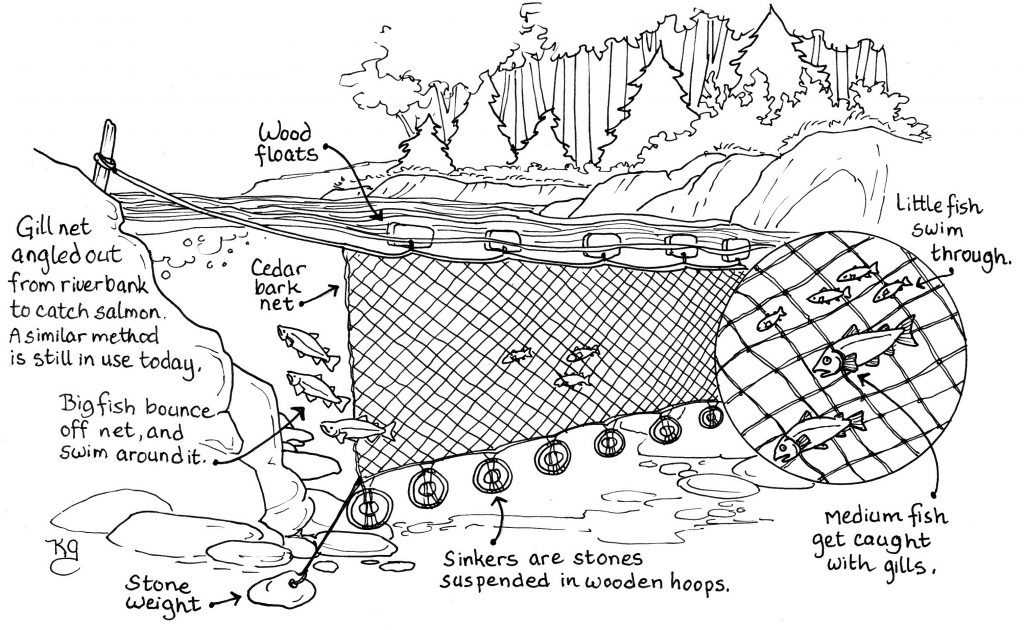
Traps and weirs, probably the most productive of any type of fishing device, allowed large quantities of fish to be caught at a time when the salmon runs were at their peak. Weirs—fences through which water flowed—were either built right across a shallow river or angled to guide the migrating fish into traps.
For the WSÁNEĆ (the people of southern Vancouver Island, Gulf Islands, San Juan Islands, and across to the Fraser River), the reef net fishery formed the core of Saanich society. The SXOLE—reef net—refers to the material that the net was constructed of—the inner bark of the willow tree, most likely the Pacific willow or the Hooker’s willow (Figure 7.26). The method of fishing was an incredibly sophisticated technique that required in-depth knowledge of the salmon, their habits and travel routes, tides, currents, and of plants, among other things.
The reef net consisted of cedar log buoys, cedar ropes to form the sides and the floor of the net, and specifically made rock weights. Dune grass was threaded through the twining of the ropes that formed the floor and the sides, allowing the net to blend with its surroundings. The net was suspended between two canoes, and would hang out with the flow of the tide. After a school of salmon entered the net, the rear anchor lines would be released and the tide would bring the canoes together. The salmon could be rolled into the canoes and brought ashore.
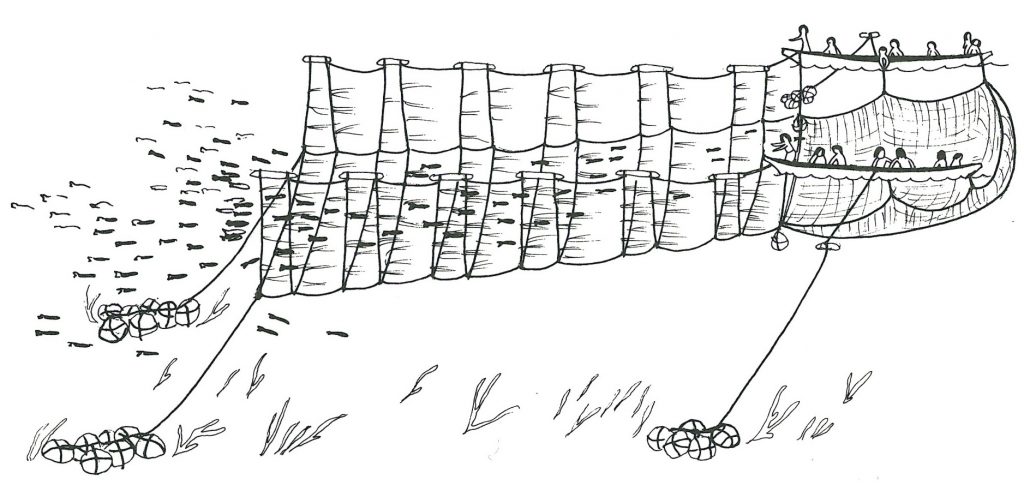
The method of fishing, according to Nick Claxton (2016), reflects a deep respect for the salmon, the earth, and each other:
It was believed that the runs of salmon were lineages, and if some were allowed to return to their home rivers, then those lineages would always continue. The WSÁNEĆ people believed that all living things were once people, and they were respected as such. The salmon were their relatives. All things on earth were to be respected since it is the earth that we all share. (p. 19)
The WSÁNEĆ people successfully governed their traditional fisheries for thousands of years prior to contact. This was because the WSÁNEĆ people followed strict fishing practices based on respect. For example, at the end of the net, a ring of willow was woven into it, which allowed some salmon to escape. According to Claxton (2016), this fishing method, combined with a profound respect for the salmon, allowed a sustainable fishery over the millennia:
Out of respect, when the first large sockeye was caught, a first salmon ceremony was conducted. This was the WSÁNEĆ way to greet and welcome the king of all salmon. All fishing would cease and the celebration would likely last up to 10 days …. Taking time to celebrate allowed for a major portion of the salmon stocks to return to their rivers to spawn, and to sustain those lineages or stocks. (p. 20)
Claxton asserts that this kind of respect for salmon and all of creation is an integral part of what it means to be a WSÁNEĆ person.
Fish Cultivation and Enhancement
Canada’s most recent volcanic eruption, dated 260 years ago (about 1750), created a 30km long lava flow that blocked the great Nass River, creating the newly formed Lava Lake and Tseax River (Tseax = “new river” in the Nisga’a language). Traditional Nisga’a stories include graphic descriptions of an eruption that emitted deadly gasses and a flow of fiery lava that buried a village of some 2,000 residents. In 1978, Wii gadim xsgaak, the Eagle Tribe Chief and historian, related that when the lava flow blocked the Nass River, it prevented the ascent of spawning salmon. Nisga’a survivors placed spawning fish in bentwood cedar boxes filled with water and packed them past the blockage, thereby ensuring the survival of these stocks (Wii gadim xsgaak to John Corsiglia, personal communication, 1977).
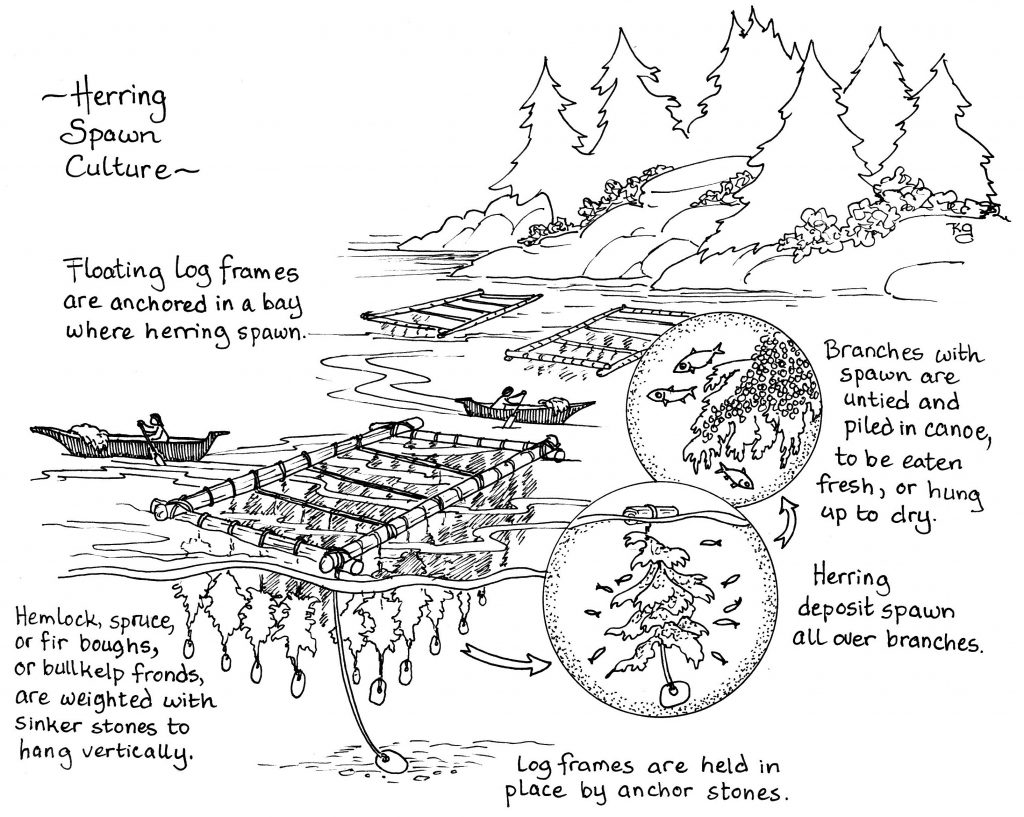
Practical cultivation of herring along the BC and Alaska coastline probably began with attempts to improve and concentrate spawning habitat. Interviews and oral history from Elders in southwest Alaska document transplantation as a cultivation technique. Knowing when the herring would congregate in certain bays and coves to deposit their eggs, the fishermen would fall trees or place branches in quiet water or hang branches or kelp from floating log frames for the fish to deposit their eggs (Figure 7.27). This herring roe on kelp fishery continues in some locations to this day. Elders speak of allowing the herring to spawn their eggs on tree branches and “waiting until eyes were almost forming on the eggs” (Thornton, 2010, p. 12). Then they slowly towed the heavily laden tree (or lifted the branches and piled them into canoes for transport) to designated locations. Elders have continued the practice by cultivating herring in places where populations have declined. Harvey Kitka (Sitka tribal leader) explains, “As long as you get them back in the water within three days, they’ll swim away” (p. 12). Clearly, for hundreds and possibly thousands of years the Nisga’a, as well as other tribes, developed forms of fish enhancement that preceded modern fish enhancement practices.
Estuarine Root-vegetable Gardens
According to ethnographic accounts, the demand for root vegetables that grow in the lower zones of estuaries was quite high along much of the northwest coast, specifically silverweed (Argentina egedii), springbank clover (Trifolium wormskjoldii), and northern rice root lily (Fritillaria camschatcensis) (Figures 7.28, 7.29, 7.30). The roots were a primary source of dietary carbohydrates and other nutrients for most pre-contact Northwest Coast peoples (Deur, 2005; Turner & Peacock, 2005, Turner, 2014b) (Figures 7.31, 7.32, 7.33). These Indigenous people understood the differing physical conditions caused by the tide, and that organisms live in certain population zones on the shore. This understanding led to an increase in the production of edible root gardens by taking advantage of optimal tidal estuarine habitats and in some cases building rock or wood terraces in the low intertidal zones.
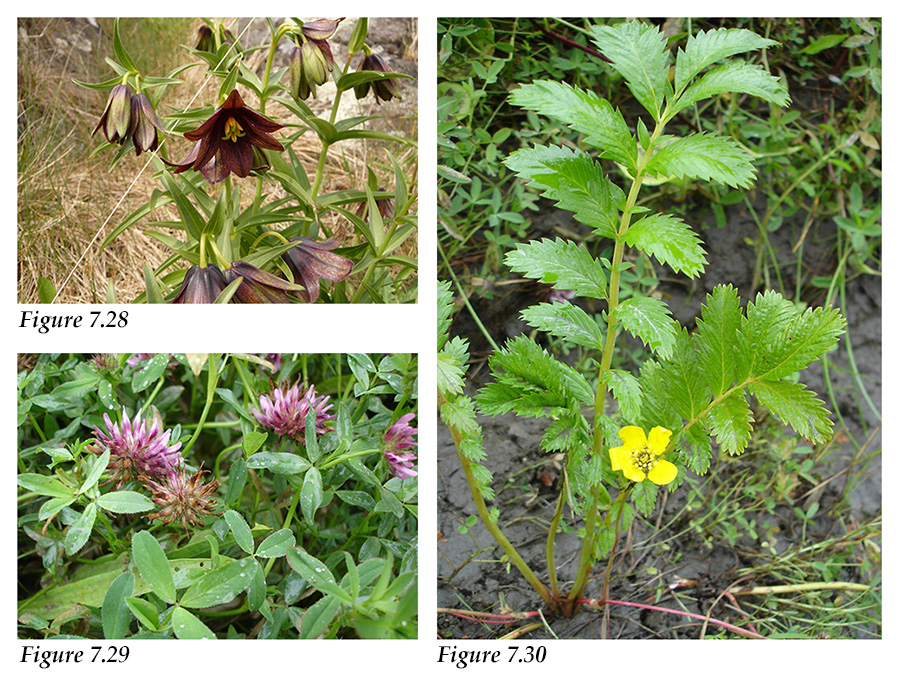
Figure 7.29 ▲ Springbank Clover. Photo by Abe Lloyd (2008).
Figure 7.30 ▲ Pacific Silverweed. Photo by Abe Lloyd (2008).

Figure 7.32 ▲ Pacific Silverweed roots. Photo by Abe Lloyd (2008).
Figure 7.33 ▲ Springbank Clover roots. Photo by Nancy Turner (2005).
The rock terraces located in the high marsh served to elevate lower portions of the salt marsh on a backfill surface and made the gardens bigger. Importantly, mounding and the construction of durable rock or wood retaining walls allowed the seaward expansion of the very narrow band of the high salt marsh in which the preferred vegetables grow. By raising the position of the planting surface relative to the tidal column, the mounded soils appear to have altered local hydrology and nutrient regimes dramatically, expanding this otherwise narrow portion of the intertidal zone and increasing significantly the production of preferred estuarine plants (Figure 7.34).
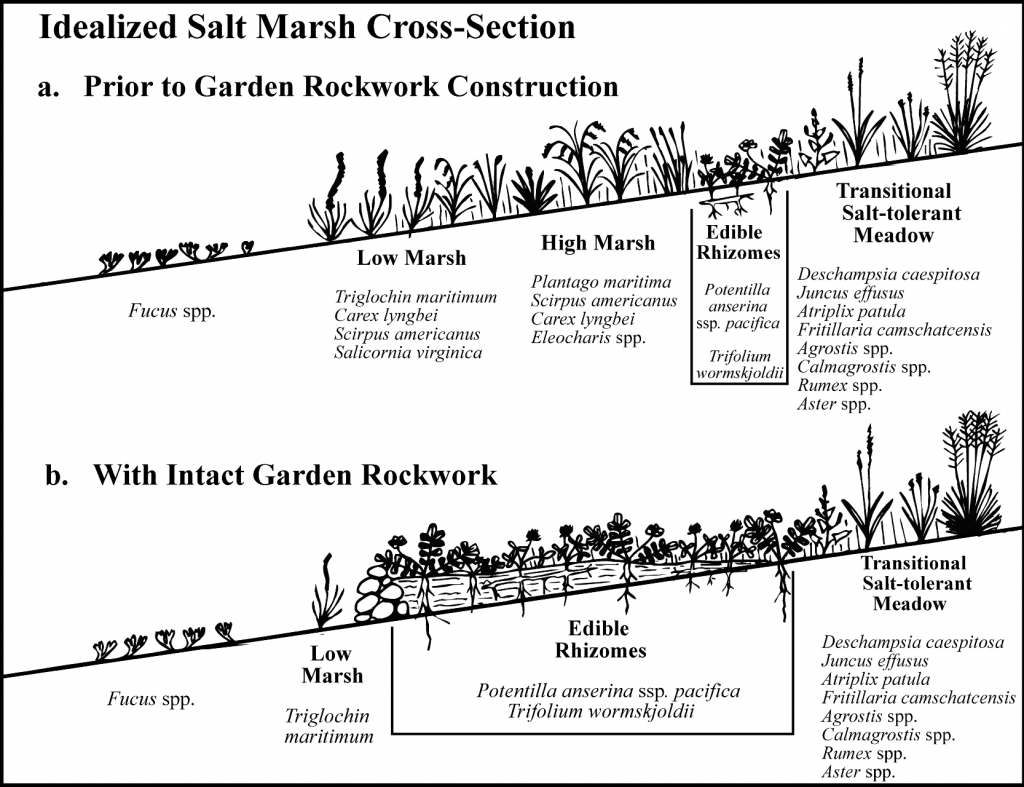
The soils that accumulated in the garden plots were rich in fresh sediments and organic detritus from riverine, estuarine, and marine sources carried to the high tide line by peak tides and floods. It made the garden plots among the most nutrient rich soils, higher in nitrogen, phosphorous, potassium, and such trace elements as calcium than unmodified marsh soils. The area was cleared or “weeded” of competing grasses, sedges and other plants to ensure good growth of the food species using specialized digging tools made of hard yew wood. Deur (2005) describes how Indigenous food producers learned to “engineer the tidal flats” in order to harness its productivity well before their first contact with Europeans:
The method of root cultivation employed reflected a detailed appreciation of the interplay of cause and effect within environmental systems …. The peoples of this coast repeatedly modified estuarine soils, plants and hydrology in anticipation of a predictable outcome: the qualitatively and quantitatively enhanced output of root foods …. (p. 300)
Plant foods contributed substantially to the diet of Northwest Coast peoples, providing them with essential vitamins and minerals, carbohydrates, and the dietary fibre required for proper digestion (Turner & Peacock, 2005). Large quantities of plant resources were acquired or traded, and were highly prized gifts at ceremonies: boxes of Pacific crabapples, highbush cranberries and bog cranberries, preserved soapberries, salal berry cakes, dried seaweed, camas bulbs, wapato tubers, silverweed and springback clover rhizomes, as well as the green shoots of thimbleberry and salmon berry, to name a few (Turner, 1995; Turner & Peacock, 2005; Turner, 2014b).
By intensifying conveniently located patches of food plants, the people of the coast reduced the risk of fluctuations of other dietary resources. As populations of salmon could fluctuate widely, it is clear that this affected Indigenous peoples and their survival strategies. Thus, the emergence of effective management strategies and the abundance of localized marine and riverine resources enabled the concentration of people together in large villages (Deur & Turner, 2005).
False Assumptions of a Colonial Past
In an attempt to understand the origin of errors, false assumptions and biases about Indigenous knowledge, the authors sketch our colonial past in the Americas. History books and various colonial papers have depicted Indigenous peoples as “hunters and gatherers,” “affluent foragers,” and “without agriculture.” Europeans proclaimed the Americas’ as Terra nullis, meaning “unoccupied land.” The cultural prejudices and the missionary, political and academic agendas of the majority culture since the time of the conquistadores served to undermine actual Indigenous knowledge and claims on the land and its natural resources. The vast majority of documentary information in the Americas was recorded by men of European background and culture—explorers, traders, settlers, colonial officials, and missionaries. It is perhaps not surprising that innovations such as Indigenous estuarine root vegetable gardens, clam gardens, and salmon enhancement practices went unnoticed or unrecognized. The claim of 19th century colonial surveyors that Northwest Coast peoples “have no aboriginal plant which they cultivate, “ or BC Governor General James Douglas’s (1859) characterization of Indigenous people as “mere wandering denizen[s] of the forest,” reveals more about the observers than the observed. Rather, these assertions served to devalue and dismiss Indigenous people’s claims to entire regions of land and resources. “Together, colonial claims regarding traditional resource use provided a façade that served the extractive ambitions of colonial and frontier economies and the expansionist territorial agendas of colonial governments and the nation state” (Deur & Turner, 2005, p. 336). In this regard, it is instructive to note that WS grew up in the service of European empire building, which accounts at least in part, for its portrayal of IK as outside the realm of “real science.” It also helps explain the emphasis in WS on domination and control of lands, resources and environment.
For Indigenous peoples in Northwestern North America, their complex knowledge systems, built up over millennia, have been threatened since European contact and globalization. Disease, epidemics, colonization, government laws, loss of lands and territory, environmental deterioration, mission and residential schools, and loss of language have all contributed to the loss of traditional knowledge systems. The result has been alarming declines in local ethno-ecological and science knowledge.
The refusal of many school jurisdictions to acknowledge IS as science, and the lack of well-funded Indigenous science curriculum projects continues to erode our understanding of the cultural knowledge and practices that sustained long-resident Indigenous peoples for thousands of years. As a result, Indigenous people in many cases have lost touch with the traditional wisdom and knowledge that sustained them for thousands of years in their homelands. Yet, Indigenous Elders and knowledge holders, as well as scholars in anthropology, ecology, biology, geology, geography, education and environmental studies agree that retaining and building on Indigenous and local knowledge systems helps support people’s capacity for social and economic resilience, food security and over-all well being (Berkes, 2012; Turner, 2014 a, 2014 b).
A fundamental focus of future curriculum development is to try and better understand how Indigenous people’s systems of knowledge developed, disseminated, adjusted, and evolved across great landscapes. What were their legacies? How did old and new practices combine and shift? What can we learn from the ancient clam gardens? Did they observe, infer, predict, theorize, evaluate, and adapt? Of importance in these times of global declining biodiversity and environmental stress, what lessons can be learned from these knowledge systems?
In writing this chapter, we sincerely hope that we have done justice to the Elders and knowledge holders who have passed on their knowledge and experiences to younger generations. We hope that all students will realize that Indigenous peoples are not simply vestiges of the past, but rather, are alive today and have much to share. We hope that in the future teachers, curriculum developers, book publishers and educational jurisdictions will develop a range of culturally appropriate Indigenous Science lessons and curricula. The best way to ensure greater accuracy is to involve knowledgeable Elders and knowledge holders in some stage of the production of those resources. Only then will generations to come, both Indigenous and non-Indigenous students, benefit from the teachings of the Elders and understand a little more clearly the richness and significance of their time-proven perspectives, knowledge, and wisdom.
This chapter provides only a brief glimpse into the vast storehouse of knowledge that developed across the great landscapes and seascapes of Northwestern North America. For a more in-depth discussion of Indigenous knowledge and wisdom examples in Northwestern North America, see selected resource books, Appendix C.
DISCUSSION POINTS
In a small group, brainstorm the following:
- How Northwestern North American Indigenous peoples discovered medicinal remedies that work (using seawrack on burns and broadleaved plantain on insect bites).
- Proponents of WS argue that “real science” is testable, evidence based, has explanatory power, and is determined by consensus. When Indigenous peoples of the northwest coast increased the production of edible root gardens by building rock terraces in the low intertidal zones, was their innovation the result of trial and error only, or can it be included in the realm of “real science?”
- To a considerable extent, culturally appropriate Indigenous Science curricula must be place-based. Discuss.
- Choose a topic such as fishing, raising house beams, tanning hides or clam gardens. Refer to Appendix A, B and C, and develop a science lesson or unit of study at a desired grade level.
REFERENCES
Berkes, F. (2012). Sacred ecology (3rd edition). New York, NY: Routledge. Retrieved from http://dx.doi.org/10.4324/9780203123843
Caldwell, M. E., Lepofsky, D., Combes, G., Washington, M., Welch, J. R., & Harper, J. R. (2012). A bird’s eye view of Northern Coast Salish intertidal resource management features, Southern British Columbia, Canada. The Journal of Island and Coastal Archaeology, 7(2), 219-233. Retrieved from http://dx.doi.org/10.1080/15564894.2011.586089
Claxton, N. X.-T. (2004). ISTÁ SĆIÁNEW, ISTÁ SXOLE – “To fish as formerly”: The Douglas Treaties and the Saanich reef net fisheries. Victoria, BC: University of Victoria. Retrieved from http://web.uvic.ca/igov/research/pdfs/To%20Fish%20as%20Formerly.pdf
Deur, D. (2005). Tending the garden, making the soil: Northwest coast estuarine gardens as engineered environments. In D. Deur & N. J. Turner (Eds.), Keeping it living: Traditions of plant use and cultivation on the Northwest Coast of North America (pp. 296-327). Seattle, WA: University of Washington Press.
Deur, D. E. & Turner, N. J. (Eds.) (2005). Keeping it living: Traditions of plant use and cultivation on the Northwest Coast of North America. Seattle, WA: University of Washington Press.
Douglas, J. (1859, March 14). Copy of despatch [sic] from Governor Douglas to the Right Hon. Sir. E. Lytton, Bart (No. 114). In British Columbia, Papers Connected with the Indian Land Question 1850-1875 (pp. 16-17). Victoria, BC: Government Printing Office. Retrieved from http://www.nuxalk.net/media/land_question_1875.pdf
Elliott, D. & Poth, J. (1983). Saltwater people: A resource book for the Saanich Native Studies program. Saanich, BC: School District No. 63.
Snively, G., & Corsiglia, J. (2001). Discovering Indigenous science: Implications for science education. Science Education, 85(1), 6-34. Retrieved from http://dx.doi.org/10.1002/1098-237X(200101)85:1<6::AID-SCE3>3.0.CO;2-R
Stewart, H. (1977). Indian Fishing: Early methods on the Northwest coast. Vancouver, BC: J.J. Douglas Ltd.
Stewart, H. (1984). Cedar: Tree of life to the Northwest coast Indians. Vancouver, BC: Douglas & McIntyre.
Thornton, T., Butler, V., Funk, F., Moss, M., Hebert, J., Elder, J., Craig, R., Hamada, S., A. M. Sheer. (2010). Herring Synthesis: Documenting and modeling herring spawning areas within socio-ecological systems over time in the southeastern Gulf of Alaska. Final Report, North Pacific Research Board Project, OR: Portland State University. Retrieved from http://herringsynthesis.research.pdx.edu/
Turner, N. J. (1991). “Burning mountain sides for better crops”: Aboriginal landscape burning in British Columbia. Archaeology in Montana, 32(2), 57-73.
Turner, N. J. (1995). Food plants of coastal First Peoples. Royal British Columbia Museum Handbook. Vancouver, BC: UBC Press.
Turner, N. J. (1998). Plant technology of First Peoples in British Columbia. Royal British Columbia Museum Handbook. Vancouver, BC: UBC Press.
Turner, N. J. (2005). The earth’s blanket: Traditional teachings for sustainable living. Vancouver, BC: Douglas & McIntyre.
Turner, N. J. (2014a). Ancient pathways, ancestral knowledge: Ethnobotany and ecological wisdom of Indigenous peoples of northwestern North America, Volume 1: The history and practice of Indigenous plant knowledge. Montreal, QC: McGill-Queen’s University Press.
Turner, N. J. (2014b). Ancient pathways, ancestral knowledge: Ethnobotany and ecological wisdom of Indigenous peoples of northwestern North America, Volume 2: The place and meaning of plants in Indigenous cultures and worldviews. Montreal, QC: McGill-Queens University Press.
Turner, N. J., & Hebda, R. J. (1990). Contemporary use of bark for medicine by two Salishan Native Elders of Southern Vancouver Island, Canada. Journal of Ethnopharmacology, 29(1), 59-72. Retrieved from http://dx.doi.org/10.1016/0378-8741(90)90098-e
Turner, N. J., & Peacock, S. (2005). Solving the perennial paradox: Ethnobotanical evidence for plant resource management on the Northwest Coast. In D. Deur & N. J. Turner (Eds.), Keeping it living: Traditions of plant use and cultivation on the Northwest Coast of North America (pp. 101-150). Seattle, WA: University of Washington Press.
Williams, J. (2006). Clam gardens: Aboriginal mariculture on Canada’s West Coast. Vancouver, BC: New Star Books.

